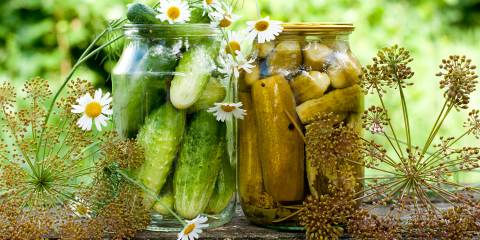Whether you’re a seasoned home cook or just trying to keep dinner from burning, these clever kitchen hacks will save you time, boost flavor, and make cooking feel a little more magical.
From making sticky syrups slide right out of the spoon, to keeping lettuce crisp for longer, you’ll wonder how you ever lived without these tricks.
Kitchenware Tips
-
Choosing and Using a Pan
-
Seasoning Cast Iron
Make sure your cast iron pan is well-seasoned before cooking anything acidic such as tomatoes, citrus, or vinegar.
Do not store food in your cast iron pan in the fridge. It can ruin the pan's seasoning.
-
Safe Non-Stick Pans
Avoid dangerous materials and sprays by choosing a safe non-stick pan.
-
-
Maintaining Cutting Tools
Always keep your knives in good shape, and pick the right tool for the job.
To eliminate odors on cutting boards, rub a cut lemon over the surface or scrub with a baking soda and water paste before washing it.
Ingredient Tips
-
Beans
-
Need Beans Fast?
No overnight soak is needed! Boil dried beans for 10 minutes, then soak for 30 minutes. After that, you can just cook until tender.
-
-
Eggs
-
Beating Eggs
Beat egg whites in a copper, glass, or stainless steel bowl—never plastic.
-
Boiling Eggs
Add 1 teaspoon of salt to cold water before boiling eggs. This will prevent the shells from cracking.
-
-
Eggplant
-
Removing Bitterness
Small eggplants are fine, but larger ones require some work to reduce their bitterness.
-
With Salt
Salting can help remove the bitter alkaloid solanine, as well as help reduce the vegetable’s water content.
-
Without Salt
For a salt-free method of removing bitterness, peel the eggplant as well as the layer of flesh closest to the skin.
-
-
-
Honey and Syrup
-
Crystallized Honey?
Place the jar in warm water until smooth again.
-
Swapping Honey for Maple
When substituting maple syrup or honey for sugar in a recipe, reduce the recipe's liquid content by 1⁄4 cup.
-
Easy Measuring
Oil the measuring cup or spoon before measuring out maple syrup and honey—these sticky ingredients will slide right out.
-
-
Miso Paste
-
Substitute for Salt
Instead of adding salt to dressings and marinades, substitute miso paste. It adds more depth of flavor.
-
Blend with Liquid
Always blend miso with a bit of water, broth, or (thin) sauce before adding it to a dish.
That way, it dissolves evenly instead of forming stubborn beads.
-
-
Tomatoes
-
Choose Wisely
For long-lasting, fresh tomatoes, choose ones that are heavy and still have their stems attached.
-
-
Zesting
-
Use the Right Fruit
Always use firm citrus for zesting. Without resistance, it's futile.
-
Technique Matters
Grate by moving the fruit back and forth against the grater. Stop when you reach the bitter white pith.
-
Cooking Tips
-
Mashed Potatoes
-
Temperature and Texture
Mash potatoes when they’re piping hot. If they cool, they can become gummy. Always preheat any added liquids.
-
Baking vs. Boiling
For richer mashed potatoes, consider baking instead of boiling them. They may not be super smooth, but they will have a lot more flavor.
-
-
Oatmeal / Porridge
-
Boil with Fruit Juice
Boil millet or quinoa in fruit juice for an extra-flavorful breakfast porridge.
-
-
Salad
-
Prep Just in Time
Don’t wash salad greens until you’re ready to use them as they wilt rapidly.
-
Use a Light Touch
Don’t overdress greens with too much dressing. They should just glisten.
-
-
Sauce
-
Prep and Freeze Stock
Freeze small portions of reduced-down stocks to later drop into soups, stews, and sauces.
-
Use Cooked Vegetables
For flavor and depth (with no fat), add tomato paste and other pureed, cooked vegetables to sauces. If you wish, strain the sauce for a smoother texture.
-
Try Using Arrowroot
Arrowroot adds shine and body when used as a thickener for sauces.
-
When in Doubt, Go Nuts
Ground nuts absorb the flavors they're simmered in, and add substance to sauces, stews, and chilis.
Try adding ground cashews to Indian curries, or ground almonds to Mexican moles.
-
-
Soup
-
Skim the Fat
To remove fat from soups and stews, float large lettuce leaves on top and discard when covered with fat.
-
Storage Tips
-
Leave Room for Freezing
Liquids expand when they’re frozen. Leave a 1⁄2-inch head space at the top of the container before freezing liquids.
-
Be Careful with Salt
Sea salt can corrode metal containers, so store it in glass, wood, clay, or pottery containers.
-
Keep Chili Peppers Firm
Store chili peppers for a few days in the fridge’s crisper. If they’re stored at room temperature, they go limp.
-
Avoid Browning Produce
-
Lettuce
Store lettuce away from apples and bananas, both of which emit the gas ethylene that can cause brown spots.
-
Stone Fruits
To prevent stone fruits from browning when frozen, toss them with lemon juice or white vinegar beforehand.
-
Avocados
Squeeze lemon juice over a cut avocado to keep it from browning.
Rinsing the cut surface of the avocado can also prevent browning—at least for a few hours.
-





